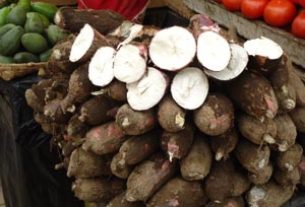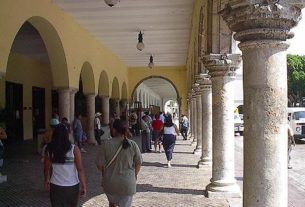Chocolate, that perennial favorite, has been accused of being sinfully delicious, overly fattening, and the precursor to teenage complexion problems. Its history is intertwined with religion, and at one point was the cause of a theological donnybrook in the Catholic church in Mexico.
“Food of the Gods,” is the literal translation of the name Theobroma. The name, given to the chocolate tree and its genus by the great botanist Carolus Linnaeus, reflects both the flavor and the history of chocolate.
When the Spaniards began to colonize and catechize Mexico, they attempted to eradicate the pagan religion of the native Indians. As happened in other parts of the world, the Church successfully stamped out many pagan customs while keeping some of the best parts of the culture. The cults of various saints replaced those of pagan gods, and medicinal and other useful plants were renamed for Our Lord, Our Lady, or one of the saints, and continued to be used. In Mexico, the Aztec drink chocolatl was taken from its Aztec ceremonial use and retained by the Spanish as a tasty beverage and as a medicine.
By the late 1600’s, the grand ladies of the land had become so fond of this frothy beverage that they were accustomed to having it served to them frequently, even in church. As justification for their enjoyment, they referred to its medicinal use, and claimed it prevented fainting and “weakness” during the long ceremonies. One bishop considered it a blatant abuse, and forbad the practice. Drinking chocolate in church obviously broke the fast laws. (Not to mention that so much pleasure must be pagan!) The ladies, in retaliation, simply took themselves and their entourage to another church. A rumor holds that the offending clergyman later died of a cup of poisoned chocolate. The whole affair became a fearful scandal. Eventually, in 1662, Pope Alexander VII put a final solution to the affair when he declared ” Liquidum non frangit jejunum.” [Liquids (including chocolate) do not break the fast.] It is likely that this decision was based on the fact that chocolate, like so many other herbs, was considered to have medicinal qualities.
Although Christopher Columbus was the first European to see and taste chocolate, it was the Spanish explorer Hernando Cortez who introduced it to Europe. In 1519, Cortez and his men witnessed a strange ceremony at the court of Montezuma, the supreme emperor of the Aztecs. Seated high on a golden throne in front of his reverent subjects, Montezuma repeatedly drank a dark brown, foamy beverage called chocolatl from a golden goblet. Ground cocoa beans mixed with water and fermented corn were whipped to a froth with a molinillo, a wooden stick with a fluted head. As the Indians served the Spanish the same bitter drink, they explained that the seeds came from paradise, and that each sip would bring wisdom and knowledge.
Most of what we know of the history of chocolate before Cortez first tasted it at Montezuma’s court is based on conjecture, myth, and circumstantial evidence. The first cocoa trees probably grew in the Amazon and Orinoco valleys more than four thousand years ago. They were cultivated by the Maya who carried seed with them when they migrated to the Yucatán about the seventh century; the plant was spread through Central America by the Aztecs. The word chocolate derives from the Aztec/Maya word chocolatl, the name the Indians gave the cold bitter drink made from ground cocoa beans mixed with liquid. The word cocoa is derived from the Aztec/Mexican word cachuatl, which comes from the word cacahuazintl, the name of the fruit or pod of the cocoa tree. Legend claims the drink was intoxicating, but although the Aztec cocoa beans contained the stimulants caffeine and theobromine, and were undoubtedly more potent than today’s cultivated ones, the Indian chocolatl was often made by mixing the ground beans with fermented corn mash or wine and was drunk in large quantities. Montezuma himself drank 50 cups a day, believing each was blessed by the Aztec god Quetzalcoatl.
According to Aztec myth, the god Quetzalcoatl brought the seeds of the cocoa tree from the Garden of Life and gave them to man. At first, the god lived in harmony with the other gods and with man, but eventually fell from grace and was banished. He promised to return, and many historians believe that the hospitality with which the Aztecs greeted Cortez was because they believed he was the returning golden haired God. Although the myth varied from tribe to tribe in its details, all the Indians considered cocoa an important crop. The beans were so valuable that the Indians even used them as a form of currency. Ten of the beans would buy a turkey or a rabbit; for 100 you could obtain a human slave.
Many of the religious practices of the Indians were to insure a good harvest. The Itza Indians, it is said, at the start of the planting season, sacrificed a human prisoner to their goddesses. The victims were given cups of chocolatl to turn their hearts to chocolate and then their hearts were torn from their bodies and offered to the goddesses. In Nicaragua, the sacrifice was less bloody and involved weeks of sexual abstinence before planting.
Cortez praised chocolate effusively in a letter to Charles V, king of Spain, and brought a supply home with him. He also established a cocoa plantation to grow “money” for the king and, as he traveled, he planted cocoa beans on the islands he explored. About 1550, the nuns of a Mexican convent made the bitter drink more palatable with the addition of vanilla and sugar.
The Spanish enthusiasm for the drink was passed to the French court with the marriage of Marie Therese, a chocolate enthusiast of the first order, to Louis IV in 1660. Here, the drink was considered an aphrodisiac and happily imbibed by those of the wealthy classes who could afford it. The popular drink was also spread throughout Europe when the Spanish friars carried the beverage with them from monastery to monastery. Originally, the Europeans mixed their chocolate with water, coffee, wine and a number of fermented drinks, as well as with pepper and other spices. The English and the Dutch added milk and established chocolate houses in the early 1700s. It was touted as a medicine in Britain, being “especially helpful for children and in cases of consumption (tuberculosis.) Until the nineteenth century, chocolate was only used as a drink. Today’s candy bars and solid chocolate confections came into being only after the first “eating” chocolate was introduced by the English chocolate company of Fry and Sons in 1847.
Today, as we enjoy our steaming hot chocolate on a cool winter’s day, or one of the hundreds of other delicious treats created by the world’s dedicated chocophiles, who would dream that the Church once said “no” to chocolate?
Sidebar:
Although Montezuma drank his frothy chocolatl cold, we can enjoy a delicious whipped version of hot Mexican chocolate. If you don’t have a molinillo, (you can probably find one in a specialty shop or the Mexican food section of your grocery store), beat your chocolate with a whisk or eggbeater.
In a bowl, put 1 cup sugar, 1/2 cup cocoa powder, and mix with enough water to make a thin paste. In a large pan, bring to a boil 4 cups milk.
Break 2 – 4″ cinnamon sticks into the milk.
Reduce heat and simmer 5 minutes.
Carefully stir in the cocoa mix.
Turn off heat and whip to a froth just before serving.
Another interesting and very popular use of chocolate was invented by the nuns of a convent in Pueblo, Mexico. A visiting bishop was coming for Sunday dinner and the cook created a special dish in his honor with a peppery sauce over turkey, one of the native birds. At the last minute, she grated in some bitter chocolate, and called the sauce ” mole.” Because of its long list of ingredients, even the best of Mexican cooks today often use the sauce purchased ready-made for a delicious chicken dish. You can find a jar of mole sauce in the Mexican food section of your grocery or in a specialty shop, and the recipe on the jar works just fine.



